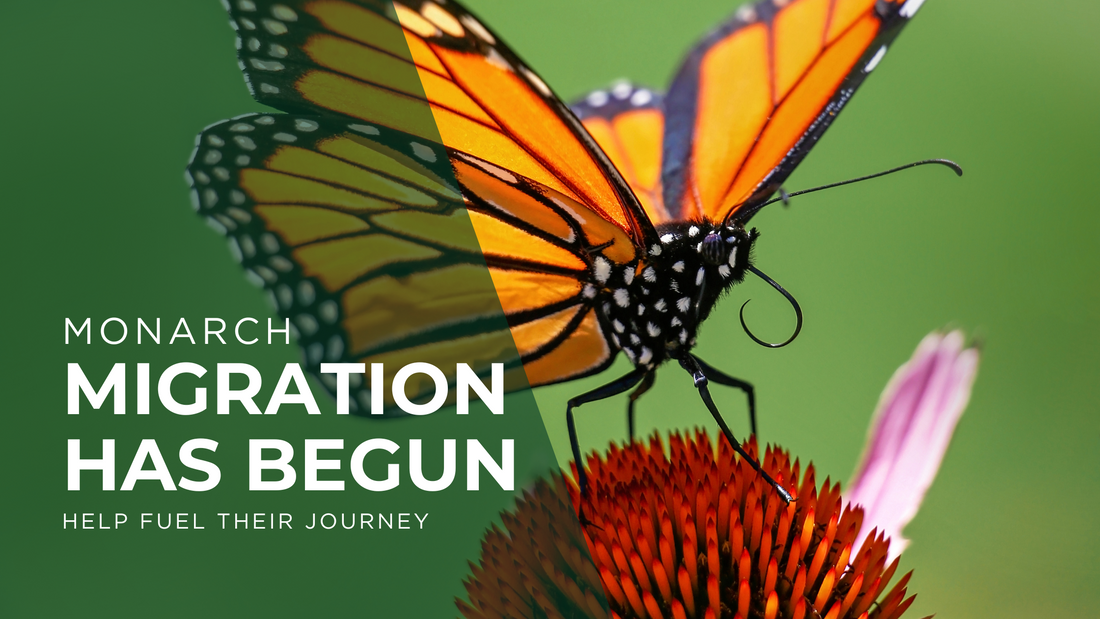Each fall, millions of Monarch butterflies embark on one of nature’s most remarkable journeys — a multi-generational migration spanning thousands of miles from Canada and the northern U.S. to their wintering grounds in Mexico and California.
Along the way, these delicate travelers depend on scattered patches of habitat for food and rest. Unfortunately, much of their native range has been replaced by development, turfgrass, and pesticide-heavy landscapes, leaving fewer safe places to refuel.
The good news? You don’t need acres of land to make a difference. Whether you have a backyard, a front yard, or even just a sunny corner, you can create a Monarch-friendly stopover that supports their migration — and it all starts with planting the right native species.
Why Monarchs Need Fall Support
According to the U.S. Forest Service and Xerces Society, Monarchs rely on two key habitat elements during migration:
- Late-season nectar sources to fuel their flight.
- Shelter to rest and recover between long stretches of travel.
Without these resources along the migration route, butterflies face exhaustion, starvation, and reduced survival rates—which is why fall-blooming wildflowers and protective grasses are so important.
What Do Monarchs Eat?
Monarch caterpillars have a very specific diet, they feed exclusively on milkweed (plants in the Asclepias genus). Female Monarchs carefully seek out these plants to lay their eggs, ensuring that the emerging caterpillars have a ready food source. The young caterpillars stay on the same milkweed plant from hatching until they’re ready to pupate.
Adult Monarchs, on the other hand, drink nectar from a variety of native flowering plants, which is why creating a habitat with both milkweed and a range of nectar-rich blooms is so important. This ensures food for every stage of their life cycle.
Do Monarchs Come Back to the Same Garden?
Many people wonder if the Monarchs they see each summer are the same butterflies returning year after year. In reality, eastern Monarchs go through about four generations each year, so the butterflies visiting your garden are likely several generations removed from those you saw the previous season.
The final generation each fall — known as the migratory generation — makes the long journey to Mexico, where they overwinter before beginning the trip north in spring. Along the way, they reproduce, and their offspring continue the migration. By the time Monarchs reach northern breeding grounds again, they’re the great-grandchildren of those that left the previous fall.
Fall-Friendly Flowers and Habitat-Supporting Grasses in Our Mix
Wildflowers for Fall Nectar:
Our blend includes key native species that provide vital late-season blooms for migrating Monarchs.
- Black-eyed Susan and Blanketflower keep producing nectar into the fall, offering a critical food source when Monarchs are passing through.
- Blue Vervain blooms through late summer and often stretches into early fall, bridging the gap between summer flowers and cooler weather.
- Early bloomers like Columbine support pollinators earlier in the season, ensuring a steady food supply from spring to fall.
Native Grasses for Shelter and Resilience:
While native grasses don’t provide nectar, they play a crucial role in habitat structure. The National Wildlife Federation notes that tall native grasses create shelter from wind, roosting spots, and microclimates that help Monarchs conserve energy.
- Little Bluestem and Sideoats Grama provide natural windbreaks and safe roosting spots.
- Prairie Dropseed and Prairie Junegrass add structural diversity, supporting the overall health of your pollinator habitat.
Start Your Monarch-Friendly Habitat Today
You don’t have to wait until spring to support Monarchs—fall planting is one of the best ways to establish native plants for next year. Cooler weather and autumn rains help seeds settle in and begin developing strong root systems over winter, setting the stage for vibrant blooms next season.
By planting our Pollinator Paradise Native Seed Mix or other native blends, you’re joining a growing movement to restore pollinator habitats and protect Monarch butterflies for future generations.
Want to learn more about Monarch conservation? Visit Monarch Joint Venture for research, migration maps, and community projects you can join.

